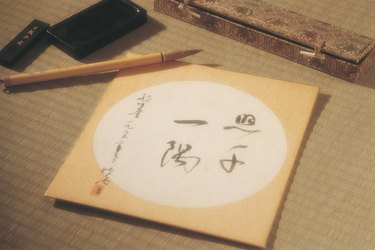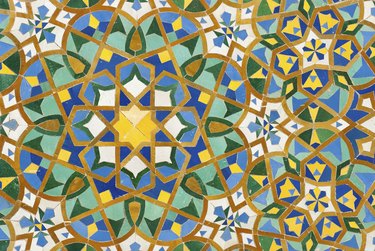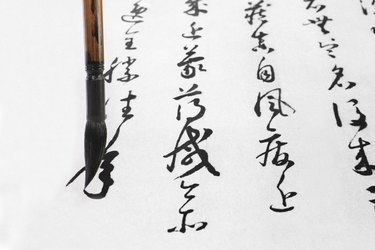
Non-Western art refers to any art objects originating from the cultures and societies outside of the Western world. The West includes the cultures of Europe and the arts utilizing European aesthetics. Arts of colonized areas such as the United States, Australia, New Zealand and Canada are considered the West, but the arts from the native peoples of these countries are referred to as non-Western art.
Language
Video of the Day

In societies with no written language, song, stories and theater served as ways to pass on information about history, creation myths and morality tales as well as entertainment. In other non-Western cultures, languages have a long literary history and writing became a visual as well as literary art. The elegant and skillful execution of calligraphy became important aspects of art in such places as Arabia, Persia, India and China.
Video of the Day
Abstract Designs

Muslim prohibitions on displaying the human form mean that Islamic art and architecture is abstract and much of the artistic design is focused around the language. Abstract, non-literal images such as arabesques, geometric tile designs, architecture and fountains became vessels or artistic expression rather than statues and paintings of human or animal subjects. Calligraphy, especially of religious lines and excerpts from the Koran, is found on art objects and architectural structures.
Contemporary Arts

The arts in the non-Western world continue to evolve and develop as much as contemporary arts do in the West. Societies with ancient roots don't stay in the past in regard to artistic works, but continue to experiment and build on the traditional arts. In the latter half of the 20th century and into the 21st century, China developed a thriving modern art scene. Calligraphers Mokhtar and Kamel El Baba produce contemporary takes on the classical art of Arabic calligraphy.
Fusion

In some colonized areas, the fusion of European or other influences are more prominent than others in regards to art and aesthetics. Latin American arts often feature a strong Spanish influence, though in certain areas you can notice a significant African influence. Quilting in Hawaii uses the Western fundamentals of sewing techniques, but features traditional Hawaiian design.
Portraits

You can find examples of portraiture and sculptures in many cultures around the world. The arts of Asia often include commissioned portraits of emperors and empresses, and even gods and deities. Images from Hinduism and Buddhism, as well as of pagan and animist deities are found in countries such as China, Korea, India, Nepal, Japan, Tibet and Thailand. Ancient Egyptian statues often depicted gods and revered pharaohs and queens. Moai are the large statues on the pacific island of Rapa Nui (Easter Island) believed to be images of respected ancestors.